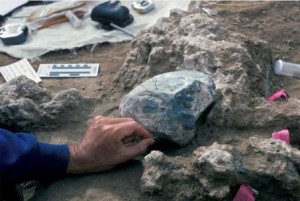
Mastodon bones, an ancestor of the now-extinct elephant, suggest that humans have arrived in America 100,000 years earlier than previously thought.
The human presence on the American continent would be 115,000 years older than was previously thought! This is the new „explosive“ announced by scientists on April 26, 2017, inviting to rethink the history of the settlement of the New World.
The remnants we have found in California suggest an initial occupation as early as 130,000 years ago,
said Judy Gradwohl, president of the San Diego Museum of Natural History, an institution that piloted the study published in the journal Nature .
The American-Australian research team says they have succeeded in dating stone tools and bones from a mammoth americanum, an ancestor of „an elephant that has now disappeared and which would bear the mark of human intervention.“
Bones and several teeth prove clearly that humans have deliberately broken them with skill and experience, “ says Steve Holen, co-author of the study. All these elements immediately triggered a wave of reactions among specialists where the subject is particularly sensitive.

Anthropologists and archaeologists are indeed divided on the origins of the settlement of the American continent. When did the first humans arrive? Where and in what way? Opinions diverge and theories are regularly questioned. Up to now, the dominant thesis was that the first men – Homo sapiens – had arrived from Asia about 14,500 years ago. A dogma periodically beaten in breach, older datings being regularly published.
Scientists claim that colonization could be carried out inland through a 1,500 km long corridor connecting East Siberia to the North American continent, which is now partly flooded under the Bering Strait.
„Dating technologies have advanced and now allow us to say with more certainty that the first humans were there much earlier than was commonly accepted,“ said Thomas Demere, a paleontologist at the San Diego Natural History Museum, also co-author of the study.
But who were these first occupants of the American continent? Probably not Homo Sapiens, the modern man. For the researchers, it is rather one of his missing cousins, Homo erectus, Neanderthal or even Denisovian …


